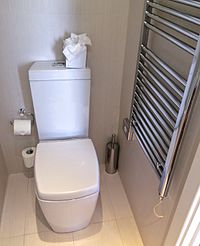
Photo from wikipedia
Abstract This paper explores the relationship between people's feelings about dirt, and an apparent reduction in the lifetime of vacuum cleaners. The short life-spans of vacuum cleaners is a significant… Click to show full abstract
Abstract This paper explores the relationship between people's feelings about dirt, and an apparent reduction in the lifetime of vacuum cleaners. The short life-spans of vacuum cleaners is a significant environmental issue. In addition to the waste generated, they have an impact on climate change: vacuum cleaners account for the second largest embodied greenhouse gas emissions of electrical goods in the UK after televisions, largely because of their high sales volumes. Drawing from qualitative and quantitative research undertaken for the UK Department for Environment, Food & Rural Affairs (Defra), the paper demonstrates that one motivation for vacuum cleaner replacement is the increased enjoyment from dirt removal that a new vacuum cleaner may provide. The paper also shows that premature disposal can occur once a product becomes dirty and visually damaged, and whilst functional, is perceived to be less effective. Solutions to premature disposal were explored through the co-creation of design concepts and design features were tested via an online survey. Vacuum cleaner users were clustered into four cleaner types; Spartan, Minimal, Caring and Manic. Overall, respondents reported that improving the ease of maintaining vacuum cleaners would be the most effective way to help them to increase their vacuum cleaner's longevity. Across all cleaner types maintenance levels were low, although Caring and Manic cleaners were significantly more likely to undertake such tasks. Motivations for disposal were similar across cleaner types and we found no evidence that Caring and Manic cleaners disposed of their machines earlier because they were ‘worn out.’ We discovered that Caring and Manic cleaners spend the most on their vacuum cleaners, vacuum more often and are the most likely to replace their machine after the shortest period. Those willing to do ‘a lot more’ to help the environment were significantly more likely to want to ‘keep the floors in my home spotlessly clean’ and significantly more likely to indicate that they preferred their vacuum cleaner to look new. Consequently, the paper proposes that design interventions to increase vacuum longevity should be targeted toward Caring and Manic cleaners and concludes with key design recommendations for these two cleaner types.
Journal Title: Journal of Cleaner Production
Year Published: 2019
Link to full text (if available)
Share on Social Media: Sign Up to like & get
recommendations!